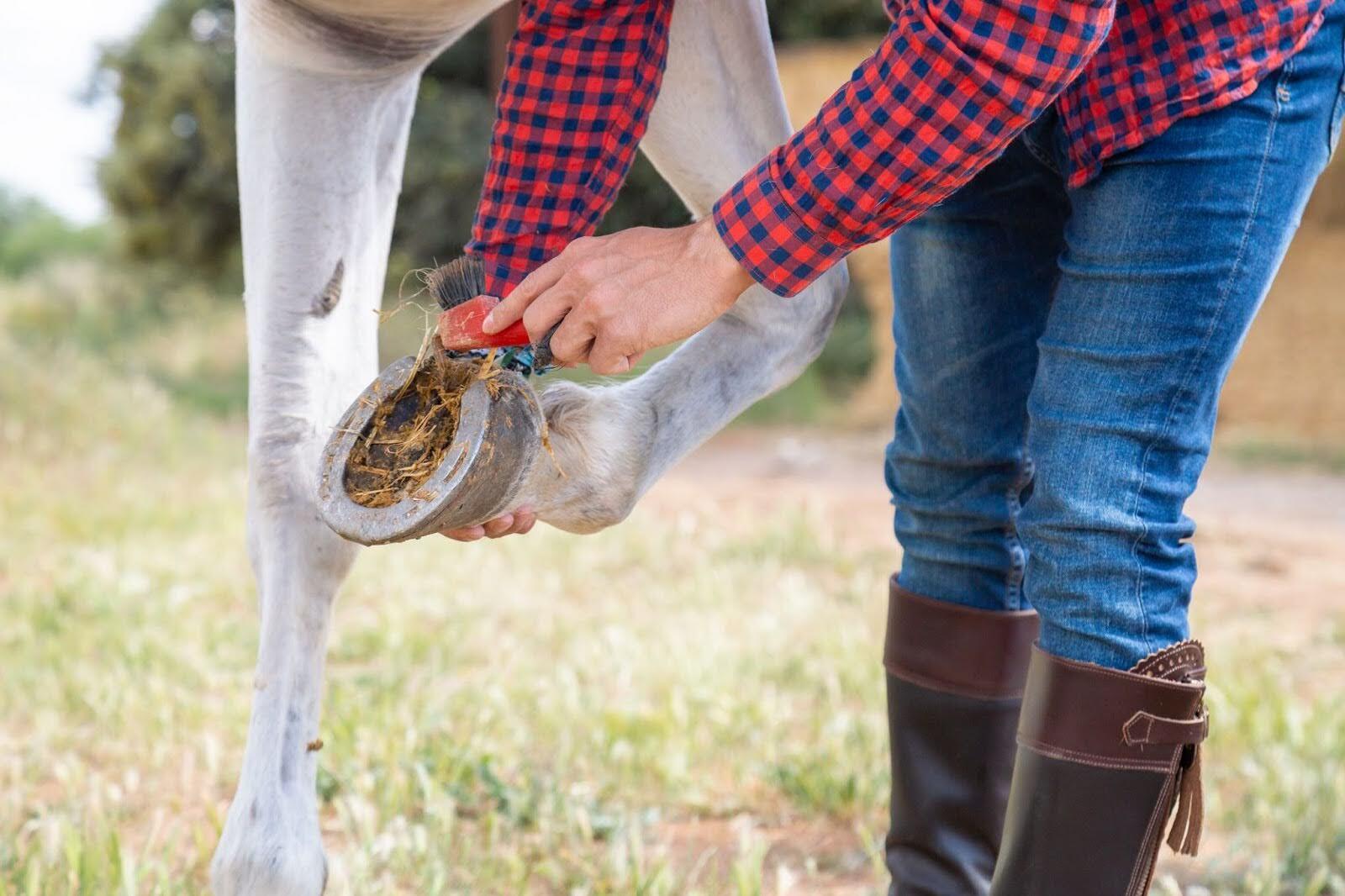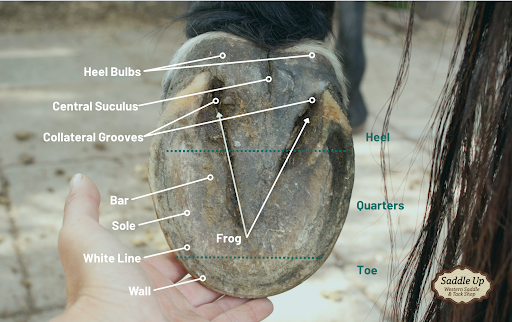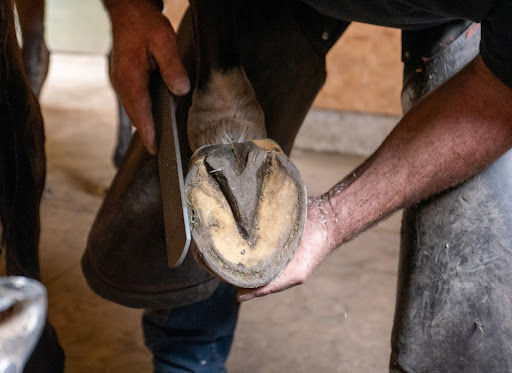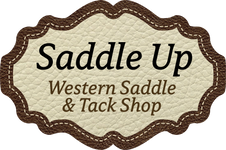Hoof Care 101: Your Guide to Caring for Your Horse’s Hooves
Posted by Lynnsy Johnson - Saddle Up on Oct 3rd 2025

If you know the saying “no hoof, no horse,” you probably know just how important hoof care is. A horse’s hooves support their entire body, absorb shock with every step, and directly influence performance, comfort, and longevity. As a horse owner, taking care of hooves is one of the most important parts of good horse care.
We’ll walk through the basics of horse hoof care, how often to schedule trims, and what you should know to keep your horse moving soundly year-round.
Understanding Horse Hooves
Before getting into routines, it helps to know what you’re looking at. The hoof is a complex structure designed to bear weight and handle impact.
- Hoof wall: The hard outer layer that provides protection and strength.
- Sole: The underside of the hoof that helps support weight.
- Frog: The V-shaped structure on the sole that aids in shock absorption and helps pump blood back up the horse’s legs with each step.
- Coronary band: The growth ring at the top of the hoof where new hoof wall tissue forms.
- White line: The junction between hoof wall and sole that secures the hoof capsule.
- Pastern axis: The alignment of the hoof with the horse’s legs – critical for balance and soundness.
- Navicular bone: A small bone inside the hoof that plays a big role in movement.
Hoof growth averages about a quarter-inch per month, meaning domestic horses need regular hoof trimming to maintain balance. Without it, they can develop problems like underrun heels, thrush, white line disease, solar abscess, or even navicular disease. Left unchecked, these issues can compromise overall health and may lead to lameness.

Routine Hoof Care Practices
Daily attention is the first step to keeping horse hooves healthy. A simple check adds only a few minutes to your routine but can prevent bigger problems later. Plus, having the right tools, like a hoof pick, applicator brush, and other quality hoof care products can make routine maintenance easier for both you and your horse.
- Pick out hooves daily: Clear out rocks, dirt, and manure to prevent thrush and infections.
- Inspect closely: Look for cracks in the hoof wall, soft spots in the sole, or foul odors that may indicate thrush.
- Schedule trims: Hoof trimming or shoe resets should typically happen every 4-8 weeks, depending on hoof growth, environment, and workload.
- Keep areas clean: Placing the water trough away from high-traffic areas helps reduce muddy spots that weaken hooves.
- Shoes or hoof boots?: Horses that work on hard surfaces or in competition often need a shoe for protection, while hoof boots can be a flexible option for trail riding or temporary use.
Helpful Tips
- Keep a hoof pick in your grooming kit and use it before and after every ride.
- Apply a hoof conditioner with an applicator brush if hooves look overly dry.
- Note down any changes in the hoof wall (chips, cracks) so you can update your farrier.
- Walk your horse in a straight line on a hard surface once a week to check for uneven movement.
Seasonal and Environmental Considerations
Just as your horse’s coat changes with the seasons, hoof care routines should adjust too. Environmental awareness is one of the simplest ways to prevent hoof problems before they start.
- Winter and colder weather: Hooves may grow slower in the winter, but frozen ground and icy conditions increase the risk of cracks and bruises.
- Hard surfaces: Riding on pavement or rocky terrain increases wear and tear on the hoof wall. Shoes or hoof boots may be needed for protection.
- Moisture management: Too much water around the hooves can lead to soft soles, thrush, and other issues, while overly dry conditions can cause brittle, cracked walls.
- Competition horses: Horses in frequent training or competition often require more frequent shoeing and monitoring for hoof balance and heel angle.
- Nutrition support: Balanced diets with amino acids and hoof supplements can help maintain hoof health, especially in horses with brittle or weak hoof walls.
Helpful Tips
- In winter, pick hooves twice daily if your horse is turned out in snow or ice.
- Lay down gravel or mats near the water trough to prevent mud from weakening hooves.
- In hot, dry months, lightly dampen the ground in high-traffic areas to prevent overly brittle hoof walls.
- Keep a pair of hoof boots on hand for unexpected rides on rocky or hard surfaces.

Working with Hoof Care Professionals
Even the most diligent horse owner can’t replace the expertise of a farrier. These professionals understand hoof structure, balance, and the impact of trimming and shoeing on movement.
- Farrier visits: Plan for every 4 to 8 weeks for barefoot horses and 3 to 6 weeks for shod horses, though hoof growth rates vary.
- Hoof care professionals: A skilled farrier can spot changes in the pastern axis, heel angle, or hoof wall long before issues escalate.
- When to call a vet: Persistent lameness, recurring hoof abscess, or signs of navicular disease may require veterinary diagnostics alongside farrier care.
- Total cost: Regular trims or shoeing may range anywhere from $50-$150+ per visit, depending on region and whether your horse requires specialized shoes. Over a year, this adds up, but it’s far less costly than treating a chronic hoof disease.
Helpful Tips
- Schedule trims early – waiting too long makes hoof trimming harder on your horse.
- Ask your farrier to explain the pastern axis and heel angle so you understand your horse’s balance.
- Discuss shoe options if your horse competes or spends time on hard surfaces.
- Keep a regular schedule and budget for the total cost of trims or shoeing to avoid delays.
Consistent farrier care, combined with your daily routine, is the best investment you can make in your horse’s long-term soundness.
Essential Takeaways for Horse Owners
Equine hoof care isn’t complicated, but it does demand consistency.
What You Can Do
- Inspect and pick out hooves daily.
- Schedule (or perform) hoof trimming or shoe resets every 4-8 weeks.
- Adjust routines for winter, hard surfaces, or high-competition horses.
- Invest in quality hoof care products, hoof supplements, and the right tools.
- Work with a knowledgeable farrier to catch small problems early.
Healthy hooves are the foundation for a happy, sound horse. By staying proactive, you’ll reduce the risk of long-term problems and give your horse the best chance at a long, active life.
Putting Hoof Care into Practice
Taking care of a horse’s hooves is about protecting their comfort, mobility, and overall health. With daily checks, seasonal adjustments, and regular support from hoof care professionals, you’ll keep your horse in top shape from pasture to competition arena.
At Saddle Up Colorado, we’re here to support horse owners with trusted hoof care products, tools, and supplies designed to make your routine easier. With the right approach, your horse will have healthy hooves – and that means more miles, more rides, and more time together.
